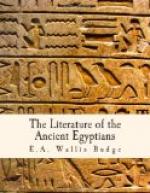Teta replied, “Behold, O king my lord, I shall
not bring the box to thee.” His Majesty
asked, “Who then shall bring it to me?”
Teta answered, “The oldest of the three children
of Rut-tetet shall bring it unto thee.”
His Majesty said, “It is my will that thou shalt
tell me who this Rut-tetet is.” Teta answered,
“This Rut-tetet is the wife of a priest of Ra
of Sakhabu,[1] who is about to give birth to three
children of Ra. He told her that these children
should attain to the highest dignities in the whole
country, and that the oldest of them should become
high priest[2] of Heliopolis.” On hearing
these words the heart of the king became sad; and
Teta said, “Wherefore art thou so sad, O king
my lord? Is it because of the three children?
I say unto thee, Verily thy son, verily his son, verily
one of them.” His Majesty asked, “When
will these three children be born?” Teta answered,
“Rut-tetet will give them birth on the fifteenth
day of the first month of Pert."[3] The king then
made a remark the exact meaning of which it is difficult
to follow, but from one part of it it is clear that
he expressed his determination to go and visit the
temple of Ra of Sakhabu, which seems to have been
situated on or near the great canal of the Letopolite
nome. In reply Teta declared that he would take
care that the water in the canal should be 4 cubits
(about 6 feet) deep,
i.e. that the water should
be deep enough for the royal barge to sail on the canal
without difficulty. The king then returned to
his palace and gave orders that Teta should have lodgings
given him in the house of Prince Herutataf, that he
should live with him, and that he should be provided
with one thousand bread-cakes, one hundred pots of
beer, one ox, and one hundred bundles of vegetables.
And all that the king commanded concerning Teta was
done.
[Footnote 1: A town which seems to have been
situated in the second nome or “county”
of Lower Egypt; the Greeks called the nome Letopolites.]
[Footnote 2: His official title was “Ur-mau.”]
[Footnote 3: The season Pert = November 15 —
March 15.]
THE STORY OF RUT-TETET AND
THE THREE SONS OF RA
The last section of the Westcar Papyrus deals with
the birth of the three sons of Ra, who have been mentioned
above. When the day drew nigh in which the three
sons were to be born, Ra, the Sun-god, ordered the
four goddesses, Isis, Nephthys,[1] Meskhenet,[2] and
Heqet,[3] and the god Khnemu,[4] to go and superintend
the birth of the three children, so that when they
grew up, and were exercising the functions of rule
throughout all Egypt, they should build temples to
them, and furnish the altars in them with offerings
of meat and drink in abundance. Then the four
goddesses changed themselves into the forms of dancing
women, and went to the house wherein the lady Rut-tetet
lay ill, and finding her husband, the priest of Ra,
who was called Rauser, outside, they clashed their
cymbals together, and rattled their sistra, and tried




